Life Cycle Assessment and Critical Raw Materials Analysis of Innovative Palladium-Substituted Membranes for Hydrogen Separation
Abstract
1. Introduction
2. Materials and Methods
2.1. System Description
2.2. Critical Raw Materials
2.3. Life Cycle Assessment
2.3.1. Goal and Scope
2.3.2. Functional Unit
2.3.3. System Boundaries and Modeling Assumptions
2.3.4. Life Cycle Inventory and Data Sources
2.3.5. Uncertainty Analysis
- The mass of each membrane (deposited onto 2.56 cm2 alumina substrates) was calculated by considering the mean values of surface area (s), thickness (t), atomic mass (m), and unit cell volume (v). Measuring their respective uncertainty (GSDs, GSDt, GSDm, GSDv) allowed obtaining of the uncertainty of membrane mass [47,48]. The equations regarding the GSD of a set of n values (xi) and error propagation considering the multiplication of parameters are reported below:
- 2.
- The surface area of several alumina substrates was measured, and the mean and standard deviation were obtained. The contribution of thin film roughness was neglected being lower than the error on thickness estimation, measured using the FE-SEM cross-section images. To assess the coating thickness uniformity, the measurement was repeated in several regions to obtain a distribution of values and their GSD.
- 3.
- The composition evaluation of each membrane was carried out by EDS measurements, as reported in a previous work [49], and the corresponding mass GSDs were obtained.
- 4.
- The cell parameters of the crystalline phase of the membranes and their errors were acquired by Rietveld refinement of XRD patterns. Assuming an orthorhombic crystalline structure, the unit cell volume and its error were estimated for each membrane.
3. Results and Discussions
3.1. CRM Analysis
3.2. LCA Results
4. Conclusions
Supplementary Materials
Author Contributions
Funding
Institutional Review Board Statement
Informed Consent Statement
Data Availability Statement
Conflicts of Interest
Abbreviations
| CRMs | Critical raw materials |
| SSbD | Safe and Sustainable by Design |
| LCA | Life Cycle Assessment |
| LCIA | Life Cycle Impact Assessment |
| XRD | X-ray Diffraction |
| EDS | Energy Dispersive X-ray Spectroscopy |
| FE-SEM | Field Emission Scanning Electron Microscopy |
| EI | Economic Importance |
| SR | Supply Risk |
| EF | Environmental Footprint |
| GLO | Global |
| GSD | Geometric Standard Deviation |
| HiPIMS | High-Power Impulse Magnetron Sputtering |
| PGMs | Platinum Group Metals |
References
- Abas, N.; Kalair, A.; Khan, N. Review of Fossil Fuels and Future Energy Technologies. Futures 2015, 69, 31–49. [Google Scholar] [CrossRef]
- Saini, N.; Awasthi, K. Insights into the Progress of Polymeric Nano-Composite Membranes for Hydrogen Separation and Purification in the Direction of Sustainable Energy Resources. Sep. Purif. Technol. 2022, 282, 120029. [Google Scholar] [CrossRef]
- Chuah, C.Y.; Jiang, X.; Goh, K.; Wang, R. Recent Progress in Mixed-Matrix Membranes for Hydrogen Separation. Membranes 2021, 11, 666. [Google Scholar] [CrossRef]
- Liu, C.; Zhang, X.; Zhai, J.; Li, X.; Guo, X.; He, G. Research Progress and Prospects on Hydrogen Separation Membranes. Clean Energy 2023, 7, 217–241. [Google Scholar] [CrossRef]
- Dincer, I.; Acar, C. Review and Evaluation of Hydrogen Production Methods for Better Sustainability. Int. J. Hydrog. Energy 2015, 40, 11094–11111. [Google Scholar] [CrossRef]
- Al-Mufachi, N.A.; Rees, N.V.; Steinberger-Wilkens, R. Hydrogen Selective Membranes: A Review of Palladium-Based Dense Metal Membranes. Renew. Sustain. Energy Rev. 2015, 47, 540–551. [Google Scholar] [CrossRef]
- Amandusson, H.; Ekedahl, L.-G.; Dannetun, H. Hydrogen Permeation through Surface Modified Pd and PdAg Membranes. J. Memb. Sci. 2001, 193, 35–47. [Google Scholar] [CrossRef]
- Dolan, M.D. Non-Pd BCC Alloy Membranes for Industrial Hydrogen Separation. J. Memb. Sci. 2010, 362, 12–28. [Google Scholar] [CrossRef]
- Abdul Samat, N.A.S.; Goh, P.S.; Lau, W.J.; Guo, Q.; Ismail, A.F.; Wong, K.C. Green Hydrogen Revolution: Sustainable Hydrogen Separation Using Hydrogen-Selective Nanocomposite Membrane Technology. Int. J. Hydrog. Energy 2025, 99, 458–484. [Google Scholar] [CrossRef]
- Fasolin, S.; Barison, S.; Agresti, F.; Battiston, S.; Fiameni, S.; Isopi, J.; Armelao, L. New Sustainable Multilayered Membranes Based on ZrVTi for Hydrogen Purification. Membranes 2022, 12, 722. [Google Scholar] [CrossRef]
- Grohol, M.; Veeh, C.; GROW, D. Study on the Critical Raw Materials for the EU 2023: Final Report; Publications Office of the European Union: Luxembourg, 2023. [Google Scholar] [CrossRef]
- European Commission: Directorate-General for Internal Market Entrepreneurship and SMEs, I.; Blengini, G.A.; El Latunussa, C.; Eynard, U.; Torres De Matos, C.; Wittmer, D.; Georgitzikis, K.; Pavel, C.; Carrara, S.; Mancini, L.; et al. Study on the EU’s List of Critical Raw Materials (2020)—Final Report; Publications Office of the European Union: Luxembourg, 2020. [Google Scholar] [CrossRef]
- Centre, E.C.J.R.; Caldeira, C.; Farcal, L.; Garmendia Aguirre, I.; Mancini, L.; Tosches, D.; Amelio, A.; Rasmussen, K.; Rauscher, H.; Riego Sintes, J.; et al. Safe and Sustainable by Design Chemicals and Materials—Framework for the Definition of Criteria and Evaluation Procedure for Chemicals and Materials; Publications Office of the European Union: Luxembourg, 2022. [Google Scholar] [CrossRef]
- Finkbeiner, M.; Inaba, A.; Tan, R.; Christiansen, K.; Klüppel, H.-J. The New International Standards for Life Cycle Assessment: ISO 14040 and ISO 14044. Int. J. Life Cycle Assess. 2006, 11, 80–85. [Google Scholar] [CrossRef]
- Abbate, E.; Ragas, A.M.J.; Caldeira, C.; Posthuma, L.; Garmendia Aguirre, I.; Devic, A.C.; Soeteman-Hernández, L.G.; Huijbregts, M.A.J.; Sala, S. Operationalization of the Safe and Sustainable by Design Framework for Chemicals and Materials: Challenges and Proposed Actions. Integr. Environ. Assess. Manag. 2025, 21, 245–262. [Google Scholar] [CrossRef]
- Mankins, J. Technology Readiness Level—A White Paper; Advanced Concepts Office, Office of Space Access and Technology, National Aeronautics and Space Administration (NASA): Washington, DC, USA, 1995. [Google Scholar]
- Waiyaki, P.; Thekkethil, R.; Ananthakumar, M.; Seshadri, S. How Green Is Green Hydrogen?─A Life-Cycle and Critical Raw Material Analysis of Green Hydrogen Production via PEMW Electrolysers in India. Energy Fuels 2025, 39, 5534–5549. [Google Scholar] [CrossRef]
- Centre, E.C.J.R.; Caldeira, C.; Farcal, R.; Moretti, C.; Mancini, L.; Rauscher, H.; Riego Sintes, J.; Sala, S.; Rasmussen, K. Safe and Sustainable by Design Chemicals and Materials—Review of Safety and Sustainability Dimensions, Aspects, Methods, Indicators, and Tools; Publications Office of the European Union: Luxembourg, 2022. [Google Scholar]
- Cespi, D. Procedural Life Cycle Inventory of Chemical Products at Laboratory and Pilot Scale: A Compendium. Green Chem. 2024, 26, 9554–9568. [Google Scholar] [CrossRef]
- Graedel, T.E.; Harper, E.M.; Nassar, N.T.; Nuss, P.; Reck, B.K. Criticality of Metals and Metalloids. Proc. Natl. Acad. Sci. USA 2015, 112, 4257–4262. [Google Scholar] [CrossRef]
- Zin, V.; Fiameni, S.; Mohtashamifar, A.; Battiston, S.; Montagner, F.; Deambrosis, S.M.; Losurdo, M. Environmental Sustainability of High-Power Impulse Magnetron Sputtering Nitriding Treatment of CoCrMo Alloys for Orthopedic Application: A Life Cycle Assessment Coupled with Critical Raw Material Analysis. Sustainability 2025, 17, 5629. [Google Scholar] [CrossRef]
- Schropp, E.; Campos-Carriedo, F.; Iribarren, D.; Naumann, G.; Bernäcker, C.; Gaderer, M.; Dufour, J. Environmental and Material Criticality Assessment of Hydrogen Production via Anion Exchange Membrane Electrolysis. Appl. Energy 2024, 356, 122247. [Google Scholar] [CrossRef]
- Martinez-Diaz, D.; Leo, P.; Sanz, R.; Carrero, A.; Calles, J.A.; Alique, D. Life Cycle Assessment of H2-Selective Pd Membranes Fabricated by Electroless Pore-Plating. J. Clean. Prod. 2021, 316, 128229. [Google Scholar] [CrossRef]
- Alique, D.; Leo, P.; Martinez-Diaz, D.; Calles, J.A.; Sanz, R. Environmental and Cost Assessments Criteria for Selection of Promising Palladium Membranes Fabrication Strategies. Int. J. Hydrog. Energy 2024, 51, 302–319. [Google Scholar] [CrossRef]
- Escalante, Y.; Tarditi, A.M. Thermally Stable Membranes Based on PdNiAu Systems with High Nickel Content for Hydrogen Separation. J. Memb. Sci. 2023, 676, 121581. [Google Scholar] [CrossRef]
- Sutar, P.R.; Yadav, G.D. Exploring the Environmental Performance of Electroless Plated Palladium Alloy Membranes for H2 Separation: A Cradle-to-Gate Life Cycle Study. Int. J. Hydrog. Energy 2024, 79, 1464–1471. [Google Scholar] [CrossRef]
- Barison, S.; Fasolin, S.; Boldrini, S.; Ferrario, A.; Romano, M.; Montagner, F.; Deambrosis, S.M.; Fabrizio, M.; Armelao, L. PdAg/Alumina Membranes Prepared by High Power Impulse Magnetron Sputtering for Hydrogen Separation. Int. J. Hydrog. Energy 2018, 43, 7982–7989. [Google Scholar] [CrossRef]
- Battiston, S.; Montagner, F.; Zin, V.; Barison, S.; Fiorese, A.; Gionda, A.; Rancan, M.; Sordello, F.; Minella, M.; Biffi, C.A.; et al. Vacuum Thermal Treatments for Surface Engineering of Selective Laser Melted Ti6Al4V Alloy. J. Mater. Eng. Perform. 2021, 30, 6874–6880. [Google Scholar] [CrossRef]
- Alami, J.; Persson, P.O.Å.; Music, D.; Gudmundsson, J.T.; Bohlmark, J.; Helmersson, U. Ion-Assisted Physical Vapor Deposition for Enhanced Film Properties on Nonflat Surfaces. J. Vac. Sci. Technol. A 2005, 23, 278–280. [Google Scholar] [CrossRef]
- Greczynski, G.; Jensen, J.; Hultman, L. Mitigating the Geometrical Limitations of Conventional Sputtering by Controlling the Ion-to-Neutral Ratio during High Power Pulsed Magnetron Sputtering. Thin Solid Film 2011, 519, 6354–6361. [Google Scholar] [CrossRef]
- Wu, S.; Lu, Y.; Gan, W.; Chen, J.; Lai, H.; Zhou, X.; Jiang, W.; Ran, Z.; Wang, Z. Effect of TiN/Pd Catalytic Layer on Structure and Hydrogen Permeability of V92Fe4Pd4 Hydrogen Separation Alloy. J. Mater. Sci. 2025, 60, 19049–19063. [Google Scholar] [CrossRef]
- Battiston, S.; Fiameni, S.; Fasolin, S.; Barison, S.; Armelao, L. Life Cycle Environmental Impact Assessment of Lab-Scale Preparation of Porous Alumina Pellets as Substrate for Hydrogen Separation Metal Layer-Based Membranes. Int. J. Life Cycle Assess. 2023, 28, 1117–1131. [Google Scholar] [CrossRef]
- Fiameni, S.; Battiston, S.; Castellani, V.; Barison, S.; Armelao, L. Implementing Sustainability in Laboratory Activities: A Case Study on Aluminum Titanium Nitride Based Thin Film Magnetron Sputtering Deposition onto Commercial Laminated Steel. J. Clean. Prod. 2021, 285, 124869. [Google Scholar] [CrossRef]
- Karakaya, I.; Thompson, W. The Ag−Pd (Silver-Palladium) System. Bull. Alloy Phase Diagr. 1988, 9, 237–243. [Google Scholar] [CrossRef]
- Fasolin, S.; Barison, S.; Boldrini, S.; Ferrario, A.; Romano, M.; Montagner, F.; Miorin, E.; Fabrizio, M.; Armelao, L. Hydrogen Separation by Thin Vanadium-Based Multi-Layered Membranes. Int. J. Hydrog. Energy 2018, 43, 3235–3243. [Google Scholar] [CrossRef]
- Li, A.; Boyd, T.; Lim, J.C.; Grace, J.R. Development of Palladium-Alloy Membranes for Hydrogen Separation and Purification. J. Membr. Sci. Res. 2020, 6, 99–106. [Google Scholar] [CrossRef]
- Grondstoffenscanner. Available online: www.grondstoffenscanner.nl (accessed on 19 June 2025).
- Bastein, T.; Rietveld, E.; Zyl, S. Van. Materials in the Dutch Economy—A Vulnerability Assessment; TNO Innovation for Life: The Hague, The Netherlands, 2015. [Google Scholar]
- Official Journal of the European Union. Regulation (EU) 2024/1252 of the European Parliament and of the Council of 11 April 2024 Establishing a Framework for Ensuring a Secure and Sustainable Supply of Critical Raw Materials and Amending Regulations (EU) No 168/2013, (EU) 2018/858, (EU) 2018/1724 and (EU) 2019/1020 (Text with EEA Relevance); Official Journal of the European Union: Luxembourg, 2024. [Google Scholar]
- Martinez-Diaz, D.; Alique, D.; Calles, J.A.; Sanz, R. Pd-Thickness Reduction in Electroless Pore-Plated Membranes by Using Doped-Ceria as Interlayer. Int. J. Hydrog. Energy 2020, 45, 7278–7289. [Google Scholar] [CrossRef]
- Kroll, W. The Production of Ductile Titanium. Trans. Electrochem. Soc. 1940, 78, 35. [Google Scholar] [CrossRef]
- da Silva Lima, L.; Quartier, M.; Buchmayr, A.; Sanjuan-Delmás, D.; Laget, H.; Corbisier, D.; Mertens, J.; Dewulf, J. Life Cycle Assessment of Lithium-Ion Batteries and Vanadium Redox Flow Batteries-Based Renewable Energy Storage Systems. Sustain. Energy Technol. Assess. 2021, 46, 101286. [Google Scholar] [CrossRef]
- Finnveden, G.; Hauschild, M.; Ekvall, T.; Guinée, J.; Heijungs, R.; Hellweg, S.; Koehler, A.; Pennington, D.; Suh, S. Recent Developments in Life Cycle Assessment. J. Environ. Manag. 2009, 91, 1–21. [Google Scholar] [CrossRef] [PubMed]
- Goedkoop, M.; Oele, M.; Leijting, J.; Ponsioen, T.; Meijer, E. Introduction to LCA with SimaPro. Pre sustainability. 2016. Available online: www.pre-sustainability.com (accessed on 19 June 2025).
- Qin, Y.; Suh, S. What Distribution Function Do Life Cycle Inventories Follow? Int. J. Life Cycle Assess. 2017, 22, 1138–1145. [Google Scholar] [CrossRef]
- Ciroth, A.; Muller, S.; Weidema, B.; Lesage, P. Empirically Based Uncertainty Factors for the Pedigree Matrix in Ecoinvent. Int. J. Life Cycle Assess. 2016, 21, 1338–1348. [Google Scholar] [CrossRef]
- Endo, Y. Estimate of Confidence Intervals for Geometric Mean Diameter and Geometric Standard Deviation of Lognormal Size Distribution. Powder Technol. 2009, 193, 154–161. [Google Scholar] [CrossRef]
- General Chemistry Laboratories. Uncertainties in Quantities and Error Propagation. 2019. Available online: https://chem.libretexts.org/@go/page/175486 (accessed on 19 June 2025).
- Battiston, S.; Fanciulli, C.; Fiameni, S.; Famengo, A.; Fasolin, S.; Fabrizio, M. One Step Synthesis and Sintering of Ni and Zn Substituted Tetrahedrite as Thermoelectric Material. J. Alloys. Compd. 2017, 702, 75–83. [Google Scholar] [CrossRef]
- Sun, S.; Ertz, M. Life Cycle Assessment and Monte Carlo Simulation to Evaluate the Environmental Impact of Promoting LNG Vehicles. MethodsX 2020, 7, 101046. [Google Scholar] [CrossRef]
- Georgitzikis, K.; Eynard, U.; Bobba, S.; Perpetuo Coelho, F.; Ingoglia, D.; D’elia, E.; Garbossa, E. Palladium: Impact Assessment for Supply Security; European Commission: Luxembourg, 2023. [Google Scholar]
- Ciotola, A.; Fuss, M.; Colombo, S.; Poganietz, W.-R. The Potential Supply Risk of Vanadium for the Renewable Energy Transition in Germany. J. Energy Storage 2021, 33, 102094. [Google Scholar] [CrossRef]
- Carrara, S.; Bobba, S.; Blagoeva, D.; Alves Dias, P.; Cavalli, A.; Georgitzikis, K.; Grohol, M.; Itul, A.; Kuzov, T.; Latunussa, C.; et al. Supply Chain Analysis and Material Demand Forecast in Strategic Technologies and Sectors in the EU—A Foresight Study; Publications Office of the European Union: Luxembourg, 2023. [Google Scholar] [CrossRef]
- Heijungs, R.; Kleijn, R. Numerical Approaches towards Life Cycle Interpretation Five Examples. Int. J. Life Cycle Assess. 2001, 6, 141–148. [Google Scholar] [CrossRef]
- Mancini, L.; Sala, S.; Recchioni, M.; Benini, L.; Goralczyk, M.; Pennington, D. Potential of Life Cycle Assessment for Supporting the Management of Critical Raw Materials. Int. J. Life Cycle Assess. 2015, 20, 100–116. [Google Scholar] [CrossRef]
- Norgate, T.; Rajakumar, V.; Trang, S. Titanium and other light metals-Technology pathways to sustainable development. In Proceedings of the Green Processing 2004, Fremantle, Western Australia, 10–12 May 2004; pp. 105–112. [Google Scholar]
- Gao, F.; Nie, Z.; Yang, D.; Sun, B.; Liu, Y.; Gong, X.; Wang, Z. Environmental impacts analysis of titanium sponge production using Kroll process in China. J. Clean. Prod. 2018, 174, 771–779. [Google Scholar] [CrossRef]
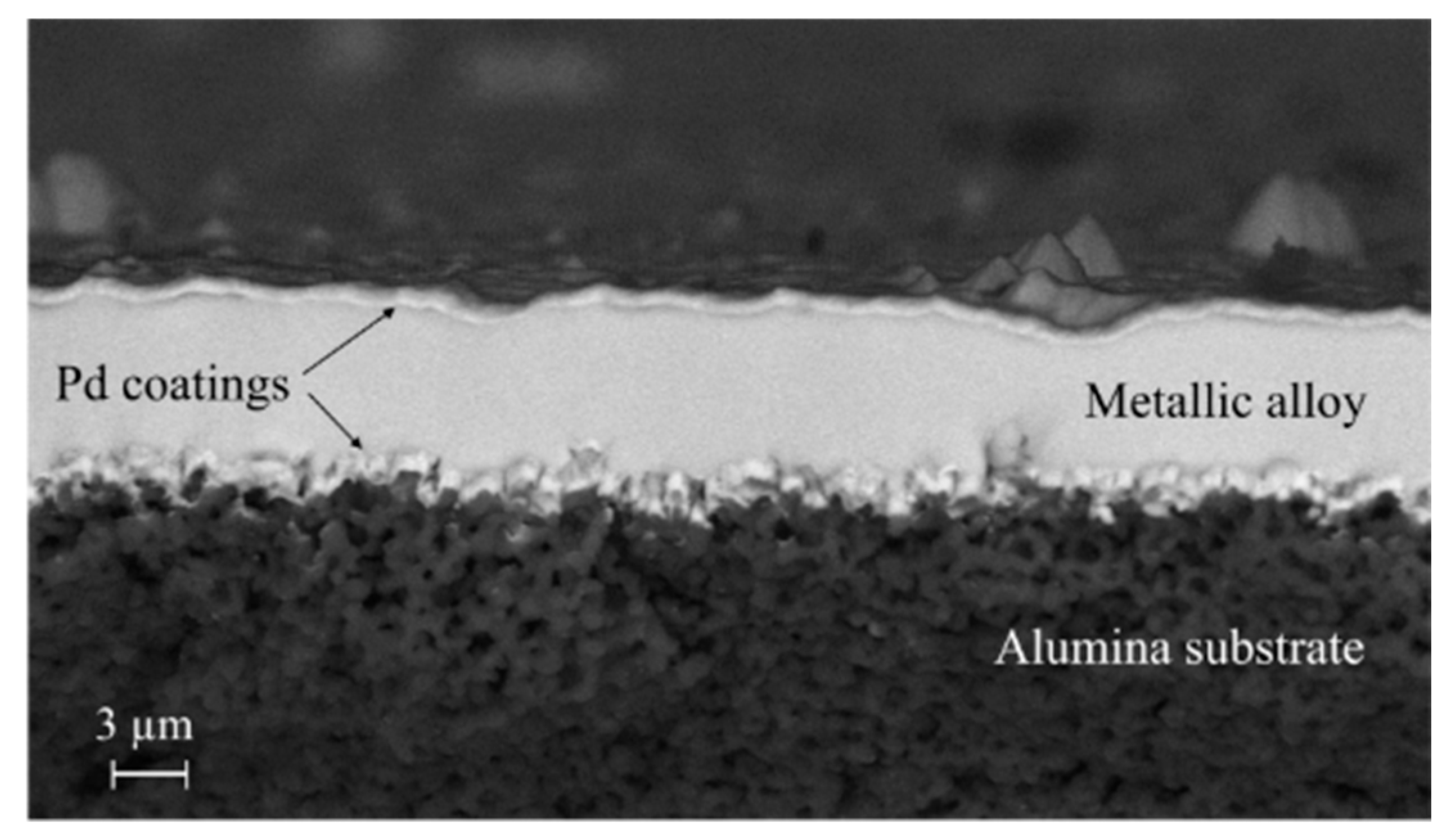
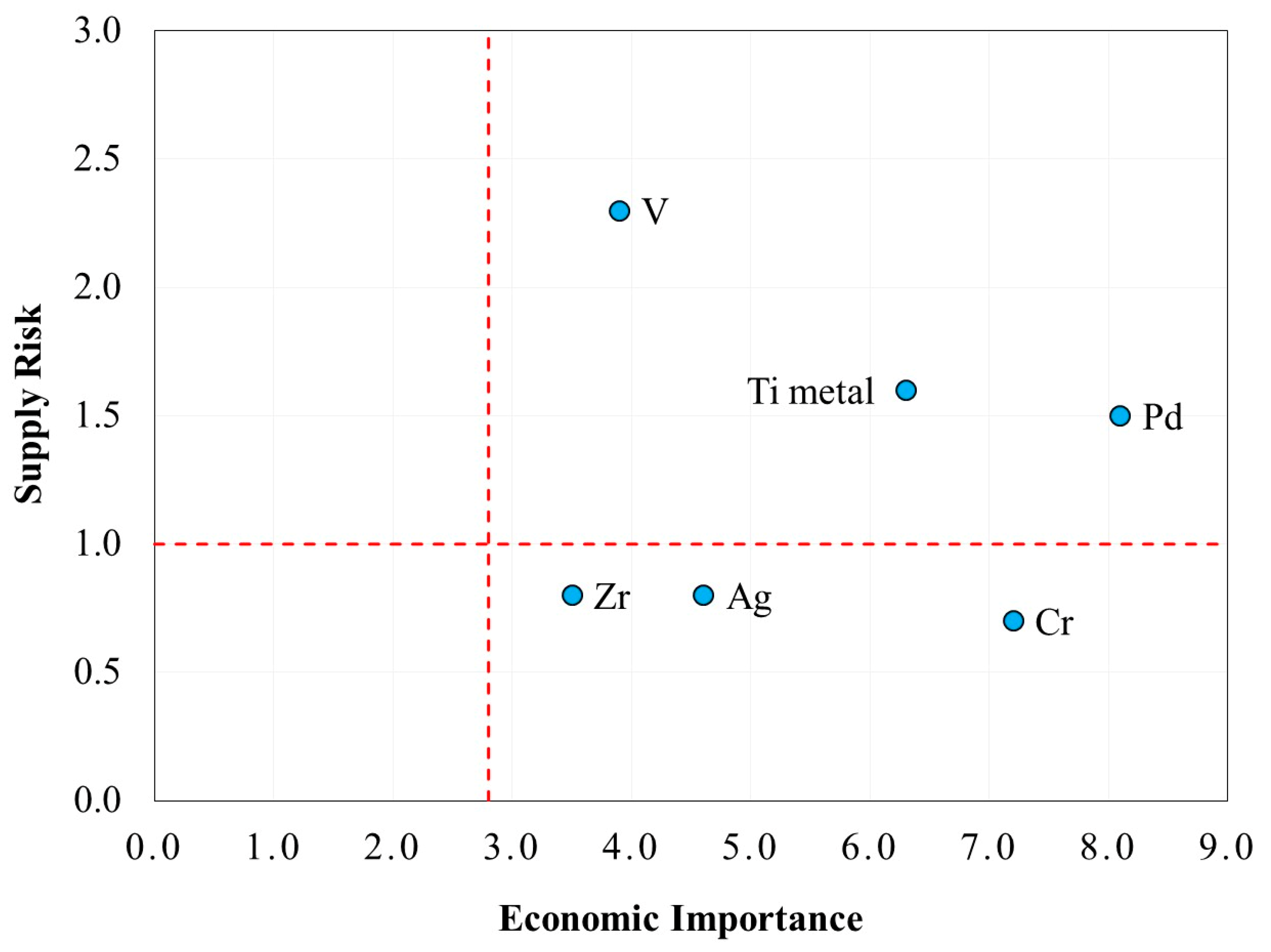
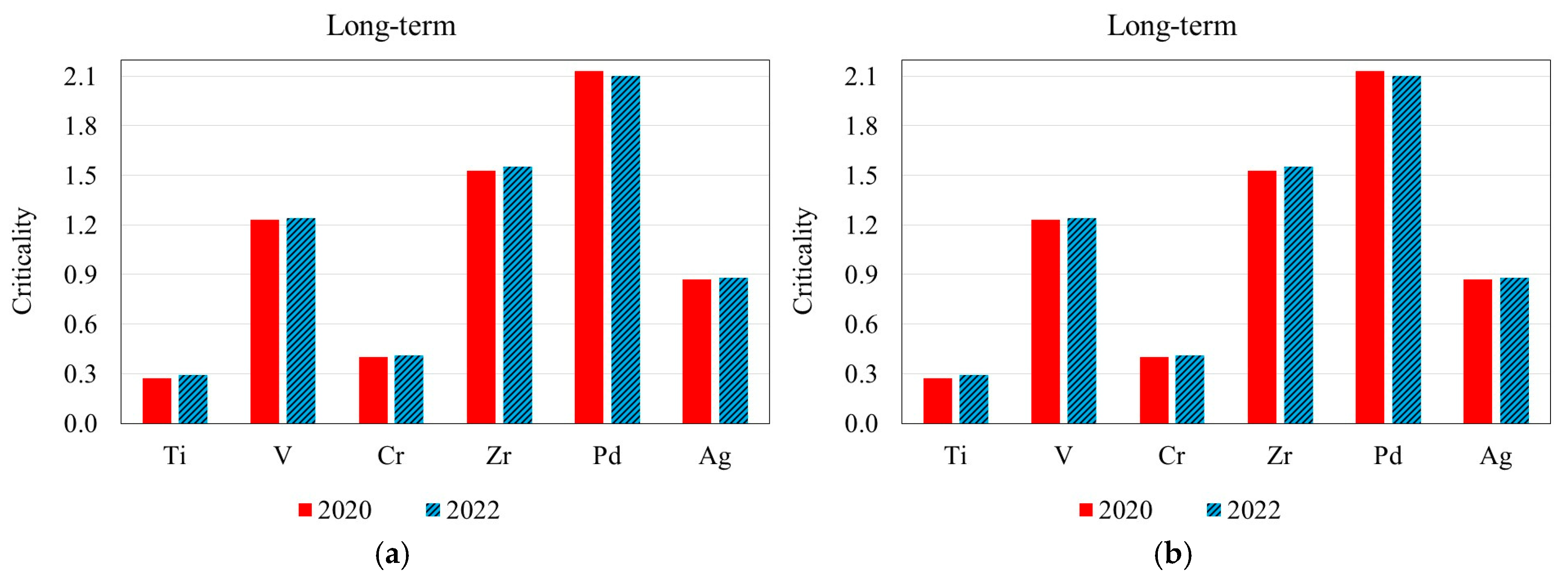
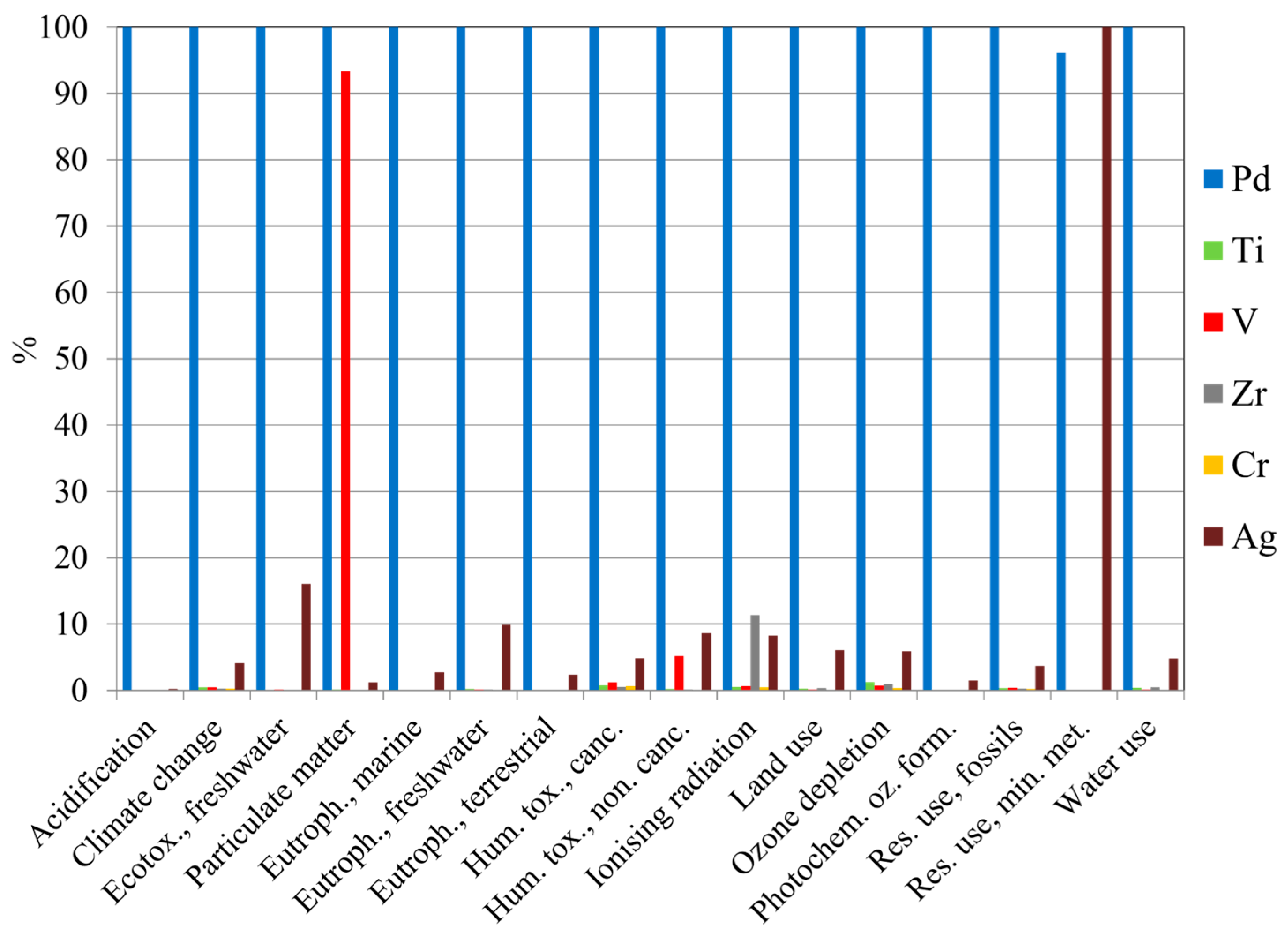
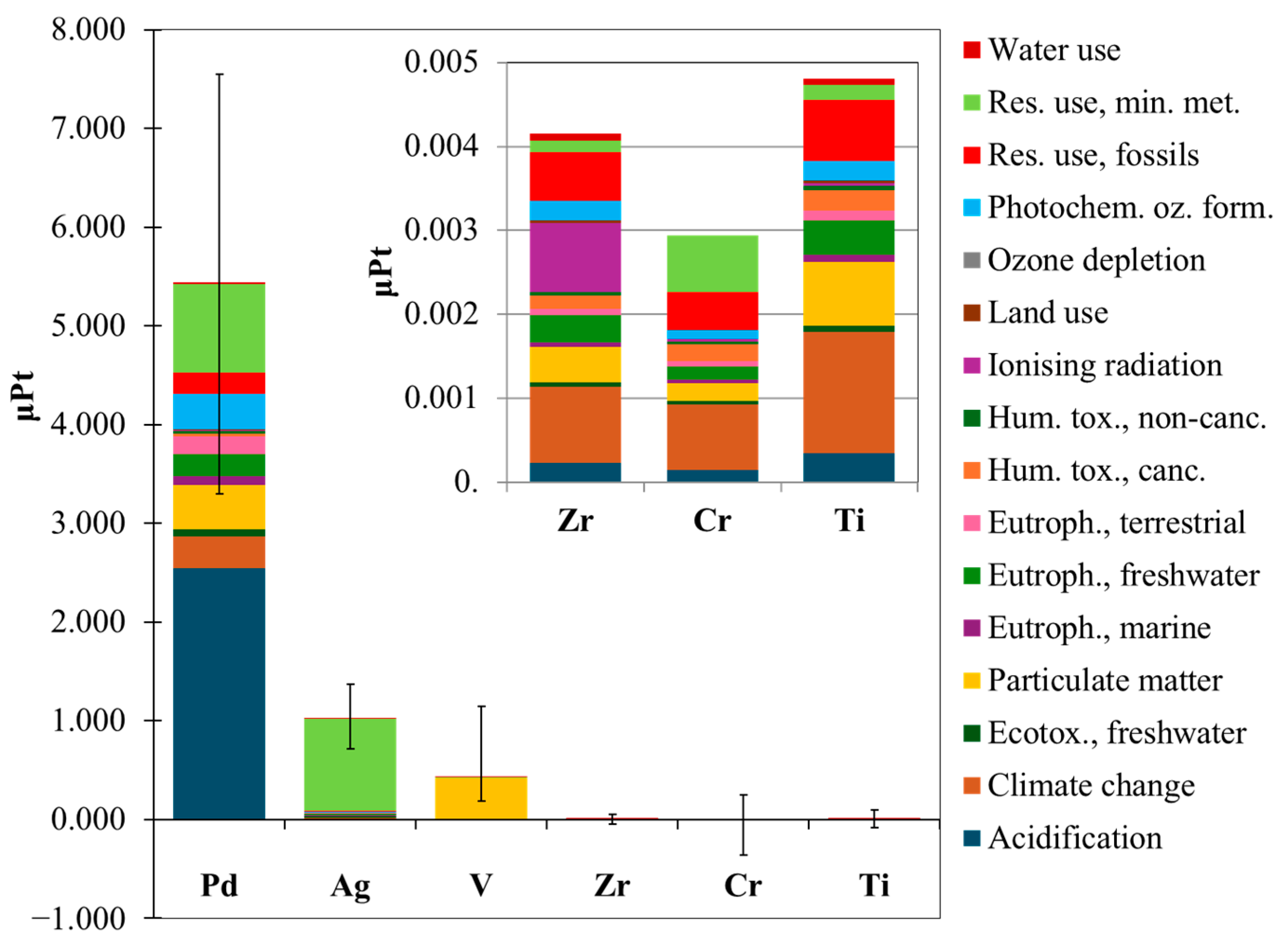

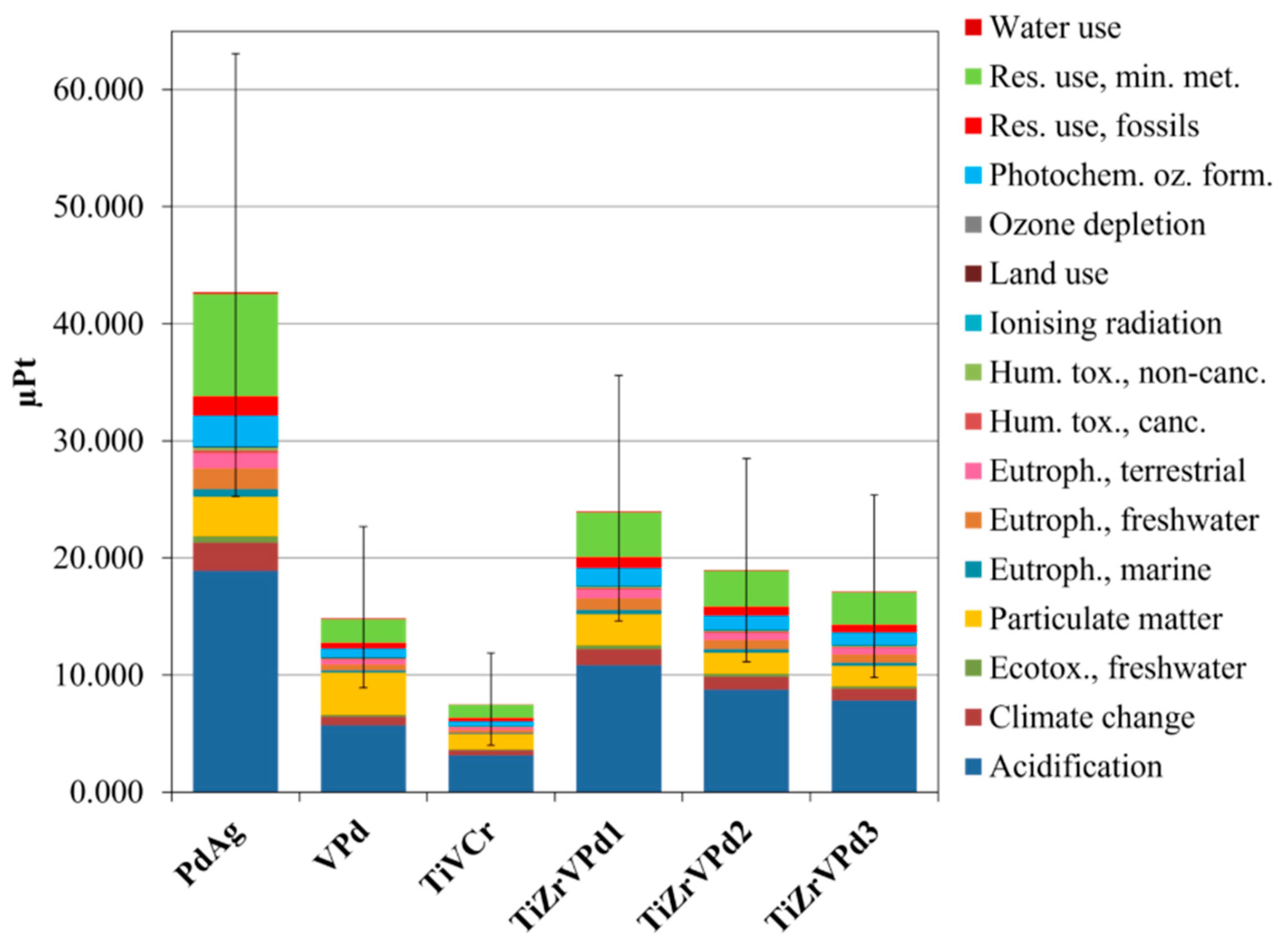
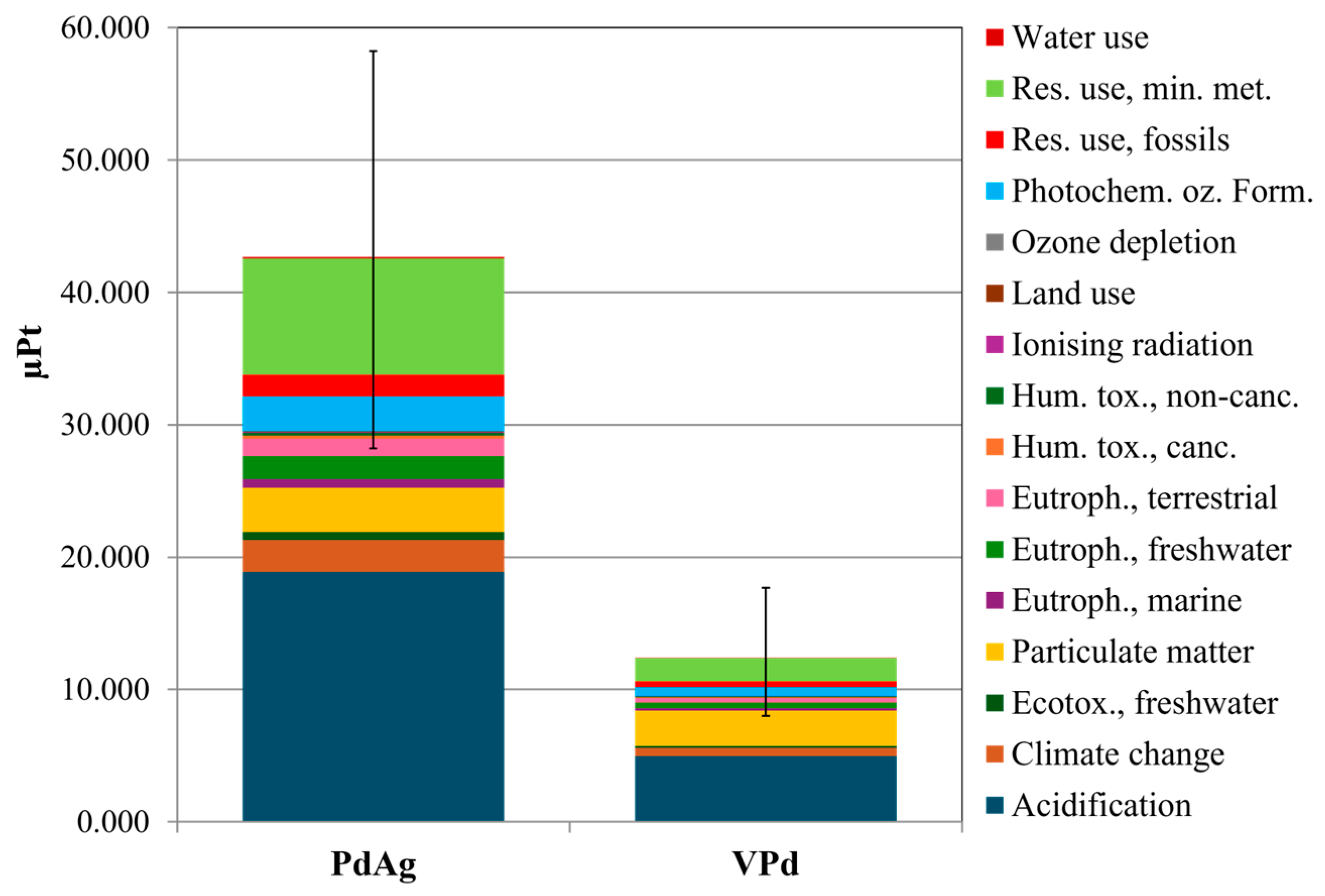
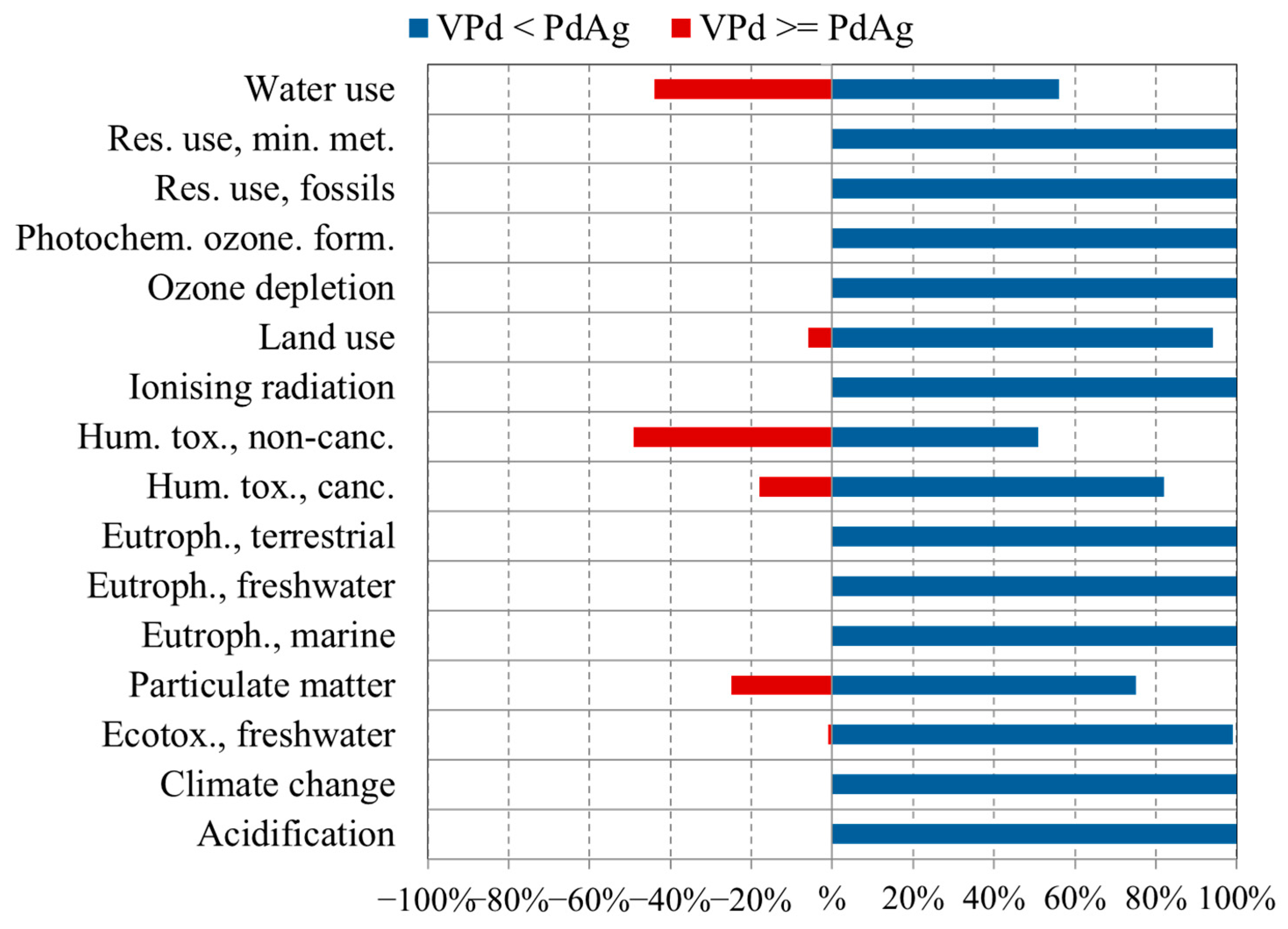
| Membrane | Composition | Thickness (μm) | Alloy Pd Content (wt%) | Permeance (mol m−2 Pa−1 s−1) | Selectivity |
|---|---|---|---|---|---|
| TiVCr | Ti20V33Cr47 | 2.0 ± 0.2 | - | 1.4 × 10−6 | 11 |
| VPd [35] | V93Pd7 | 3.5 ± 0.2 | 14% | 1.5 × 10−6 | 400 |
| PdAg [27] | Pd77Ag23 | 3.2 ± 0.2 | 65% | 2.0 × 10−6 | 222 |
| ZrVTiPd1 [10] | Zr9V34Ti30Pd27 | 4.7 ± 0.2 | 37% | 3.5 × 10−6 | 50 |
| ZrVTiPd2 [10] | Zr52V12Ti13Pd23 | 6.1 ± 0.2 | 36% | 3.5 × 10−6 | 100 |
| ZrVTiPd3 [10] | Zr39V20Ti19Pd22 | 6.4 ± 0.2 | 33% | 8.1 × 10−6 | 75 |
| Element/Ecoinvent Process | Pd77Ag23 | V93Pd7 | Ti20V33Cr47 | ZrVTiPd1 | ZrVTiPd2 | ZrVTiPd3 | |
|---|---|---|---|---|---|---|---|
| Pd | Palladium {GLO} | market for palladium| Cut-off, U | 0.768 | 0.136 | - | 0.419 | 0.291 | 0.299 |
| Ag | Silver {GLO} | market for silver | Cut-off, U | 0.232 | - | - | - | - | - |
| Cr | Chromium {GLO} | market for chromium | Cut-off, U | - | - | 0.481 | - | - | - |
| Zr | Zirconium triple-melt (modelled) | - | - | - | 0.120 | 0.563 | 0.455 |
| Ti | Titanium, triple-melt {GLO}| market for titanium, triple-melt | Cut-off, U | - | - | 0.188 | 0.209 | 0.073 | 0.116 |
| V | Vanadium triple-melt (modelled) | - | 0.864 | 0.331 | 0.252 | 0.073 | 0.130 |
| Element | P/R | Comp. | HHIres | Crit.LT | HHIprod | WGI | OECD | EOLRIR | Crit.ST |
|---|---|---|---|---|---|---|---|---|---|
| Pd | 0.16 | 0.97 | 0.97 | 2.100 | 0.34 | 0.2 | 0.00 | 0.22 | 0.053 |
| Ag | 0.02 | 0.72 | 0.14 | 0.880 | 0.1 | 0.08 | 0.00 | 0.75 | 0.002 |
| Cr | 0.15 | 0.02 | 0.24 | 0.410 | 0.22 | 0.18 | 0.02 | 1.00 | 0.000 |
| Zr | 0.03 | 1.00 | 0.52 | 1.550 | 0.21 | 0.28 | 0.00 | 0.06 | 0.055 |
| Ti | 0.10 | 0.00 | 0.19 | 0.290 | 0.11 | 0.16 | 0.00 | 0.33 | 0.012 |
| V | 0.18 | 0.74 | 0.32 | 1.240 | 0.36 | 0.28 | 0.53 | 0.01 | 0.289 |
Disclaimer/Publisher’s Note: The statements, opinions and data contained in all publications are solely those of the individual author(s) and contributor(s) and not of MDPI and/or the editor(s). MDPI and/or the editor(s) disclaim responsibility for any injury to people or property resulting from any ideas, methods, instructions or products referred to in the content. |
© 2025 by the authors. Licensee MDPI, Basel, Switzerland. This article is an open access article distributed under the terms and conditions of the Creative Commons Attribution (CC BY) license (https://creativecommons.org/licenses/by/4.0/).
Share and Cite
Mohtashamifar, A.; Battiston, S.; Fasolin, S.; Fiameni, S.; Visentin, F.; Barison, S. Life Cycle Assessment and Critical Raw Materials Analysis of Innovative Palladium-Substituted Membranes for Hydrogen Separation. Membranes 2025, 15, 310. https://doi.org/10.3390/membranes15100310
Mohtashamifar A, Battiston S, Fasolin S, Fiameni S, Visentin F, Barison S. Life Cycle Assessment and Critical Raw Materials Analysis of Innovative Palladium-Substituted Membranes for Hydrogen Separation. Membranes. 2025; 15(10):310. https://doi.org/10.3390/membranes15100310
Chicago/Turabian StyleMohtashamifar, Ali, Simone Battiston, Stefano Fasolin, Stefania Fiameni, Francesca Visentin, and Simona Barison. 2025. "Life Cycle Assessment and Critical Raw Materials Analysis of Innovative Palladium-Substituted Membranes for Hydrogen Separation" Membranes 15, no. 10: 310. https://doi.org/10.3390/membranes15100310
APA StyleMohtashamifar, A., Battiston, S., Fasolin, S., Fiameni, S., Visentin, F., & Barison, S. (2025). Life Cycle Assessment and Critical Raw Materials Analysis of Innovative Palladium-Substituted Membranes for Hydrogen Separation. Membranes, 15(10), 310. https://doi.org/10.3390/membranes15100310







